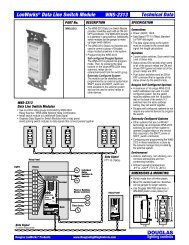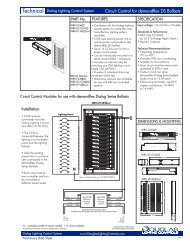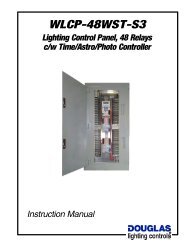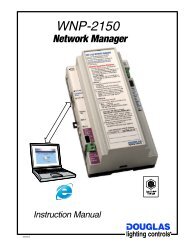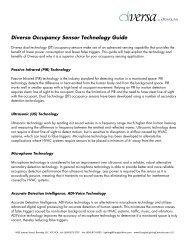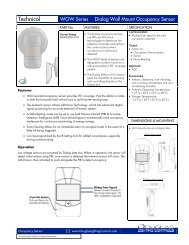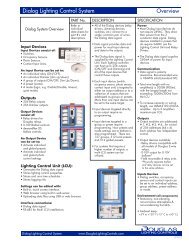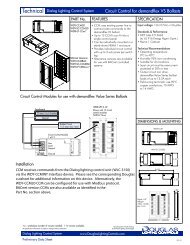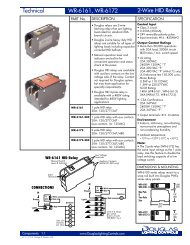WTI-2332-FT
WTI-2332-FT Telephone Interface - Douglas Lighting Control
WTI-2332-FT Telephone Interface - Douglas Lighting Control
- No tags were found...
You also want an ePaper? Increase the reach of your titles
YUMPU automatically turns print PDFs into web optimized ePapers that Google loves.
LonWorks Basics<br />
LONWORKS<br />
The <strong>WTI</strong>-<strong>2332</strong>-<strong>FT</strong> has been designed to function as part of a<br />
LonWorks network.<br />
LONWORKS refers to a technology platform for components used in<br />
control networks. A component, to be certified as LonMark (meeting<br />
the LonWorks standard), must meet the functional standards specified<br />
for its device (also called node) type. The advantage to this is<br />
interoperability. That is, in a LonWorks network, a device/node from<br />
any manufacturer can be used for performing the function specified<br />
for that particular device/node type.<br />
<strong>WTI</strong>-<strong>2332</strong>-<strong>FT</strong><br />
6.5"<br />
(165) <strong>WTI</strong>-<strong>2332</strong>-<strong>FT</strong><br />
Telephone Interface<br />
Node #4<br />
LonWorks nodes generally contain a chip called a neuron. The neuron<br />
has imbedded software that directs the node in performing its<br />
networking functions. The neuron 'listens' for messages from other<br />
LonWorks devices/nodes on the network. When it 'hears' a type of<br />
message that it is programmed to respond to, it sends a specific type<br />
of message in response.<br />
Relay #1<br />
Relays<br />
#2 & #3<br />
Relay #4<br />
CONFIGURATION<br />
A Douglas W-2000 LonWorks lighting control network consists of<br />
devices that are configured to receive/send signals to/from other<br />
devices in the network. Each device/node must have an ID and must<br />
recognize the IDs of all the other devices on the network so that it can<br />
send/receive messages to/from the appropriate devices. Each device<br />
is configured to respond in a specific manner to any message it is<br />
able to receive.<br />
In a Douglas W-2000 LonWorks network, configuration can be done<br />
by an external BAS (building automation system) connected to the<br />
network, or by a pc connected by ethernet to a Douglas WNP-2150<br />
Network Manager that is part of the network. Or, it can be done<br />
automatically (self-configured) by a Douglas WNX-2624 device within<br />
the network that is designated as the Network Manager.<br />
The BAS or Network Manager will assign ID numbers to the devices in<br />
the network as well as to each of their switch inputs and willl bind, or<br />
assign, the relay output groups to the appropriate switch inputs.<br />
The BAS or Network Manager will know which node (by its Node ID<br />
number) has which switch inputs (by their input ID numbers) and<br />
which output relays (by the binding) each of those switch inputs<br />
controls. When the system is operating and a switch input is<br />
triggered, the BAS or Network Manager will recognize where it is, will<br />
recognize which output relays it is to trigger, and will generate a signal<br />
to trigger those output relays as a group.<br />
THE <strong>WTI</strong>-<strong>2332</strong>-<strong>FT</strong> TELEPHONE INTERFACE<br />
The <strong>WTI</strong>-<strong>2332</strong>-<strong>FT</strong> Telephone Interface is LonMark-compliant and<br />
can function as device within a LonWorks network. Once properly<br />
connected and configured, it will have a unique node ID.<br />
The function of the the <strong>WTI</strong>-<strong>2332</strong>-<strong>FT</strong> is to allow the operator, who<br />
connects to the <strong>WTI</strong>-<strong>2332</strong>-<strong>FT</strong> with a touch-tone phone, to monitor<br />
the status of each of the output relay groups bound to the switch<br />
inputs throughout the LonWorks network. As well, the<br />
<strong>WTI</strong>-<strong>2332</strong>-<strong>FT</strong> will allow the operator to turn any output relay<br />
group ON or OFF.<br />
Node #1<br />
Data Signal<br />
Node #2<br />
Node #3<br />
Network Example with <strong>WTI</strong>-<strong>2332</strong>-<strong>FT</strong> Telephone Interface<br />
AN EXAMPLE<br />
An example of a Douglas W-2000 LonWorks Network with a <strong>WTI</strong>-<br />
<strong>2332</strong>-<strong>FT</strong> Telephone Interface is shown above. The network<br />
consists of three panels, each that contain the WRS-2224<br />
Programmable Relay Scanner/WNX-2624 Network Node, and a<br />
fourth panel that contains the <strong>WTI</strong>-<strong>2332</strong>-<strong>FT</strong> Telephone Interface.<br />
They are networked with a data signal that is connected to each<br />
WNX-2624 and to the input and output of the <strong>WTI</strong>-<strong>2332</strong>-<strong>FT</strong>.<br />
Node ID #'s are assigned to each of the Network Nodes and the<br />
Telephone Interface. Output group ID #'s are assigned to all the<br />
output relay groups. The output relays assigned to each output<br />
group I are bound to its group ID #.<br />
In the example above, an output group consists of four relays.<br />
The first relay (relay #1) is connected to an output on the scanner<br />
with Node #1. The second and third relays (relays #2 and #3)<br />
are connected to outputs on the scanner with Node #2. The<br />
fourth relay (relay #4) is connected to an output on the scanner<br />
with Node #3.<br />
The configuration recognizes this and assigns an Input ID number (in<br />
this example, Output Group # 18) to the switch and binds all four<br />
relays to that group number.<br />
When the operator signals the <strong>WTI</strong>-<strong>2332</strong>-<strong>FT</strong> Telephone Interface<br />
(Node #4) to turn Group #18 ON or OFF, the <strong>WTI</strong>-<strong>2332</strong>-<strong>FT</strong><br />
transmits that signal to the network and the network will turn the<br />
relays that are bound to the Group (relays #1, #2 #3 and #4)<br />
ON or OFF accordingly.<br />
<strong>WTI</strong>-<strong>2332</strong>-<strong>FT</strong>: Directions & Applications page 4 lighting controls



